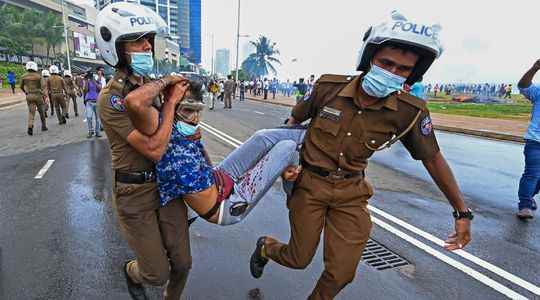“I am resigning with immediate effect so that you can appoint a multi-party government to lead the country out of the current economic crisis.” This is what Sri Lankan Prime Minister Mahinda Rajapaksa wrote in his resignation letter on Monday, May 9. Mahinda Rajapaksa, 76, sent his resignation letter to his younger brother and to President Gotabaya Rajapaksa. His departure automatically leads to the dissolution of the firm.
- The facts: protests and resignations
Mahinda Rajapaksa, leader of the Rajapaksa clan that has dominated the country’s political life for most of the past two decades, resigned shortly after clashes between his supporters and anti-government protesters left five people dead, including an MP, and more than 180 wounded, the day of May 9 being the deadliest for three weeks. Several hundred demonstrators defied the curfew and the police on Tuesday in Sri Lanka. The UN denounced the escalation of violence, asked the authorities to prevent further violence and to start a dialogue with the population, exasperated by months of serious shortages of food, fuel and medicine.
Sri Lanka has been agitated for two months by violent demonstrations demanding the departure of its leaders. On the night of March 31 to April 1, hundreds of protesters attempted to storm Gotabaya Rajapaksa’s residence in Colombo and demanded his resignation. On April 1, demonstrations against the government spread across the country. The president declares a state of emergency. On the 2nd, a 36-hour curfew was introduced but hundreds of people defied it by demonstrating in several cities. The army is deployed in support of law enforcement.
On April 3, the government resigns with the exception of the president and his older brother, Prime Minister Mahinda Rajapaksa. On the 4th, the curfew is lifted. Central Bank Governor Ajith Cabraal resigns. On the 5th, President Rajapaksa was deprived of his majority during a session in Parliament, the ruling coalition Podujana Party (SLPP) having suffered a series of defections.
On April 9, tens of thousands of people demonstrate in Colombo against the president, at the call of social networks and the Anglican and Catholic Churches. Thousands of protesters decide to camp in front of the presidential office. On the 12th, Sri Lanka defaulted on its external debt of 51 billion dollars, declaring that it was a “last resort” for the country, which had run out of foreign exchange to import essential products.
On the 18th, the President of Sri Lanka unveiled a new government, notably dismissing two of his brothers and a nephew, but keeping his older brother as Prime Minister. On the 19th, the police killed a man, the first in several weeks of protests. On the 20th, the International Monetary Fund (IMF), with which Sri Lanka had begun discussions to obtain aid of 3 to 4 billion dollars, announced that it had asked the government to “restructure” the colossal external debt before a program bailout can be finalized. On April 28, then on May 6, general strikes paralyze the country. President Rajapaksa imposes a state of emergency. The authorities decree a general curfew.
The army evacuated the resigning Prime Minister shortly before dawn on Tuesday from his official residence in Colombo, to place him in a safe place after thousands of demonstrators forced one of the gates of the complex. Mahinda Rajapaksa will not flee the country, her eldest son told AFP on Tuesday.
- The background: Sri Lanka faces its worst economic crisis
This South Asian island of 22 million people is facing its worst economic crisis since its independence in 1948 from the United Kingdom, suffering food shortagesfuel and medicine, long daily power cuts and record inflation.
Since the summer of 2021, Sri Lanka has suffered shortages of milk powder, kerosene and cooking gas. This Asian country has problems with the supply and distribution of food. President Gotabaya Rajapaksa had placed the country in a “food emergency” on August 31, 2021.
Tourism and remittances from the diaspora, vital for the economy, have collapsed during the Covid-19 pandemic. The pandemic has hit Sri Lanka’s economic activity hard which contracted by 3.6% in 2020 and hit its foreign currency reserves. The authorities have imposed a broad ban on imports in an attempt to save foreign currency.
Poor policy decisions have compounded the problems, economists say. Misguided tax cuts just before the pandemic starved the state of revenue and sent debt soaring. The current crisis threatens to wipe out hopes for a revival in the tourism sector. Before the pandemic, the 2019 Easter Islamist attacks had dried up foreign currency reserves.
- Why it matters: Sri Lanka, first country in a long list?
In addition to Sri Lanka, other emerging countries, such as Tunisia or Egypt, could experience the same fate, as underlined by The world. Fragility increased with the Russian invasion of Ukraine, which slowed global growth and fueled the oil price spikegas, wheat or oil.
According to a survey conducted by the World Bank, more than two-thirds of households in low- and middle-income countries reported a drop in income during the Covid-19 pandemic. For the first time in twenty years, 97 million additional people fell into extreme poverty in 2020-2021. A trend that unfortunately should not be reversed.
